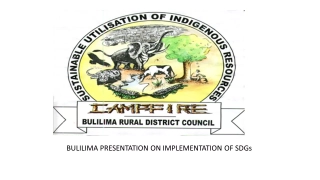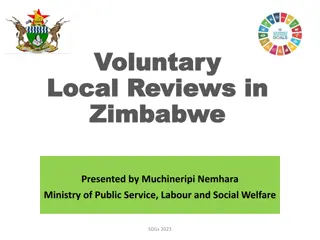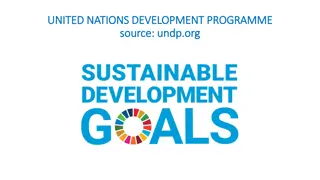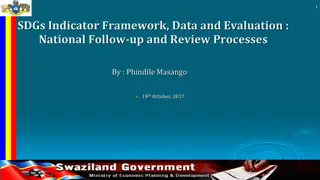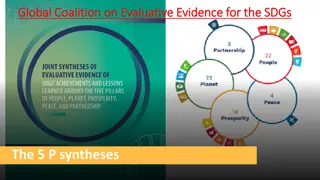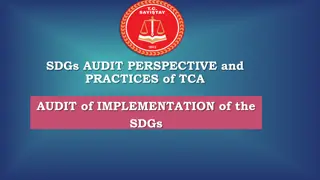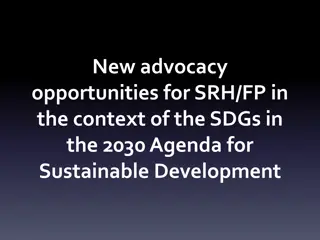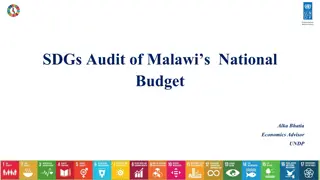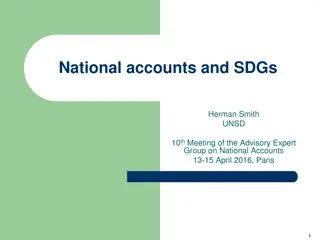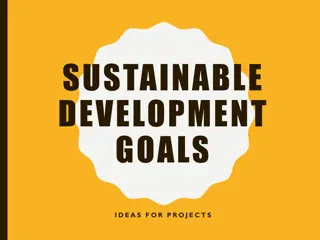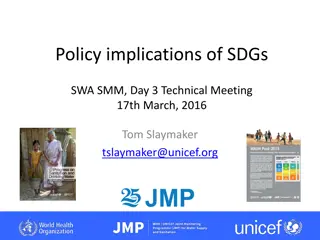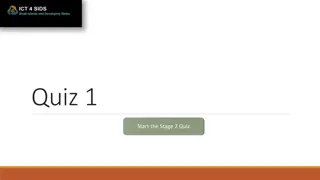Integration of SDGs into NDPs: GPEDC Data Analysis by Rebekah Chew
"Explore the integration of Sustainable Development Goals (SDGs) into National Development Plans (NDPs) through data insights from the Global Partnership for Effective Development Co-operation (GPEDC). Rebekah Chew, a Policy Specialist at the BPPS, UNDP, presents key information on aligning country priorities, civil society and private sector engagement, aid transparency, and more. Learn about the GPEDC's principles, vision, and monitoring exercises towards effective development cooperation and SDG achievement."
Download Presentation

Please find below an Image/Link to download the presentation.
The content on the website is provided AS IS for your information and personal use only. It may not be sold, licensed, or shared on other websites without obtaining consent from the author. Download presentation by click this link. If you encounter any issues during the download, it is possible that the publisher has removed the file from their server.
E N D
Presentation Transcript
Integration of SDGs into NDPs data from the GPEDC Rebekah Chew Policy Specialist Effective Development Cooperation, BPPS, UNDP On behalf of the OECD-UNDP Joint Support Team
Introduction Global Partnership for Effective Development Co-operation
Historical Timeline on Aid Effectiveness and 2030 Agenda - Focus on aid effectiveness - Established an action-oriented roadmap to improve the quality of aid - Shift to effective development co-operation - Agreement on Four Principles of effective development co- operation - Establishment of Global Partnership for Effective Development Co-operation (GPEDC/Global Partnership) Reaffirmed the crucial role of effective partnerships to achieve the SDGs Charted a path for all development actors to realise their complementary contributions to achieving the SDGs
Global Partnership for Effective Development Co-operation (GPEDC/Global Partnership) Vision: Maximise the effectiveness of all forms of co-operation for development for the shared benefits of people, planet, prosperity and peace. Key Feature: Multi-stakeholder vehicle for driving development effectiveness Key Functions: Supporting effectiveness at the country level Monitoring the commitments of all partners Sharing knowledge and lessons Facilitating specialised dialogues Building political momentum for effective development co-operation
Global Partnership Monitoring Exercise 10 Indicators 1. Alignment with country priorities 2. Civil society engagement 3. Private sector engagement 4. Aid transparency 5. Development co-operation predictable 6. Aid is on budgets which are subject to parliamentary scrutiny 7. Mutual accountability through inclusive reviews 8. Gender equality and women s empowerment 9. Effective institutions 10. Aid is untied Indicator 1B: Countries strengthen their national results frameworks Are SDGs incorporated in country s development strategy?
Results of SDGs integration into NDPs based on the 2018 monitoring Round
Results SDGs and National Development Strategies 53 (91%) reference the SDGs as strategic goals in the narrative 47 (81%) reference SDG goals N=58 40 (69 %) reference SDG targets 35 (60 %) reference SDG indicators
Results Regional perspective Latin America and Caribbean Asia Pacific reference SDGs as strategic goals in the narrative 100% 100% reference SDG goals 100% 95% N=3 N=19 reference SDG targets 67% 68% reference SDG indicators 33% 58% Africa Arab reference SDGs as strategic goals in the narrative 90% 75% reference SDG goals 76% 50% N=4 N=29 reference SDG targets 72% 50% reference SDG indicators 69% 25%
Results Income perspective Low income countries Lower middle income countries reference SDGs as strategic goals in the narrative 92% 100% reference SDG goals 79% 90% N=24 N=21 reference SDG targets 75% 71% reference SDG indicators 67% 62% Upper middle income countries High income countries reference SDGs as strategic goals in the narrative 70% 100% reference SDG goals 60% 100% N=10 N=3 reference SDG targets 50% 67% reference SDG indicators 50% 33%
Results Country context perspective LDCs SIDS (Least Developed Countries) (Small Island Developing States) reference SDGs as strategic goals in the narrative 93% 100% reference SDG goals 79% 93% N=28 N=15 reference SDG targets 64% 67% reference SDG indicators 50% 53%
Results Relation to quality of national development planning Countries with lower quality of National Development Planning Countries with high quality of National Development Planning reference SDGs as strategic goals in the narrative 89% 93% reference SDG goals 78% 83% N=18 N=40 reference SDG targets 50% 78% reference SDG indicators 33% 73%
Results Data & Stats availability Proportion of countries with SDG indicators in NDPs 12% Timely, regular, accurate government data is available to all the indicators 9% Timely, regular, accurate government data is available to all the indicators Timely, regular, accurate government data is available for most indicators 2% Only some indicators have timely, regular, accurate government data available to track progress 36% 7% 42% Timely, regular, accurate government data is available for most indicators 22% Very few indicators can be tracked relying on the national M&E system and statistics 18% N=33 Only some indicators have timely, regular, accurate government data available to track progress Proportion of countries without SDG indicators in NDPs Timely, regular, accurate government data is available to all the indicators 2% Timely, regular, accurate government data is available for most indicators 7% Very few indicators can be tracked relying on the national M&E system and statistics 22% 18% Only some indicators have timely, regular, accurate government data available to track progress 51% Very few indicators can be tracked relying on the national M&E system and statistics No indicators in the NDP 51% There are no indicators in the national development strategy or government plan. N= 45
Concluding thoughts In the past decade, partner countries have continued to strengthen their national development planning; this includes, in recent years, inclusion and integration of the 2030 Agenda and SDG targets and indicators into their national development plans. Further integration of the SDGs into national development plans, particularly at the indicator level, is needed. This goes hand-in-hand with strengthening national data and statistical systems. The next Global Partnership monitoring exercise is planned to kick off following its next High-Level Meeting in 2022.
Information on the Global Partnership available at www.effectivecooperation.org More data available at dashboard.effectivecooperation.org For specific requests, please contact monitoring@effectivecooperation.org







